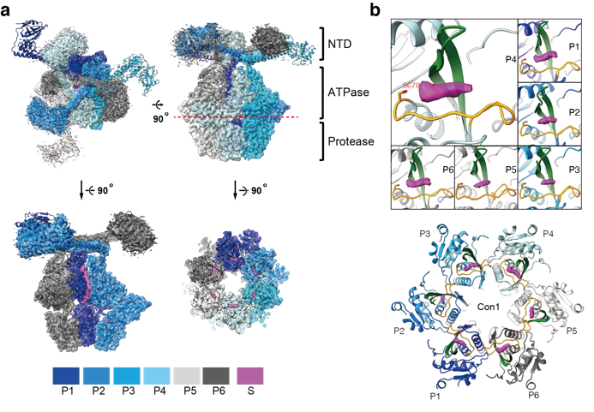


In a recent study published in Science Advances, a research team led by Prof. ZHANG Kaiming from University of Science and Technology of China (USTC) of the Chinese Academy of Sciences, and Prof. Chang Chung-i from Academia Sinica, presented structures of the substrate bound to the Lon protease active site and uncovered a previously unrecognized mechanism for processive substrate degradation by the Lon protease.

The Lon protease plays crucial biological roles in certain microorganism species by degrading certain proteins. The Lon complex is consisted of covalently linked N-terminal region, AAA+ domain, and protease domain(C-terminal region). Crystal structures have shown that the AAA+ and the protease domains form a closed chamber structure with six ATPase sites facing out and six proteolytic active sites facing in.
It is known that Lon degrades protein substrates in a processive fashion, cutting protein chains into small peptides sequentially. Previous research speculated that the closed chambers in Lon serve as separators for proteins, leading to processive protein degradation.
In this work, researchers revealed that the closed chamber in Lon is not the direct reason that leads to processive protein degradation. In fact, the processive protein degradation occurs at each individual proteolytic active site. Researchers obtained three cryo-electron microscopy (cryo-EM) maps of Lon bound to endogenous substrate at high resolutions, which showed clear density for translocating substrate polypeptide in each individual proteolytic active site. Assays of protein degradation conducted subsequently confirmed that processivity occurred at a single proteolytic active-site level.
Researchers then determined the crystal structures of various substrate polypeptides bound to Lon. They discovered that in all cases, the substrates were bound to the proteolytic active sites via their C-terminal ends and each of the six active sites formed a narrow binding groove which accommodated only the unprime residues of a substrate. The findings suggested that the protein degradation followed a C-to-N processive cleavage mechanism.
In support of the above observations, researchers identified a universally conserved acidic residue at the exit side of the binding groove indispensable for the proteolytic activity. This noncatalytic residue likely promoted processive proteolysis by carboxyl-carboxylate interactions between Lon and cleaved intermediates.
To sum up, this work reveals the mechanism of processive substrate degradation induced by the Lon protease. The results provided a complete framework for understanding the structural mechanism of Lon and other proteases with similar activity.
(Written by ZHANG Yuxin, edited by TONG Xinyang, USTC News Center)
 Back
Back